It’s kind of a cliche that travel changes you but it’s also true. India is so different than places in the West and for many people like me, it’s been a very profound experience.
Does India change you? I asked my family, friends and travelers I’ve met on some FB groups and wanted to share what I found with you here.
It’s not an easy question to answer but as I contemplate moving back to the USA one day and settling down, I’m curious what other travelers have experienced.
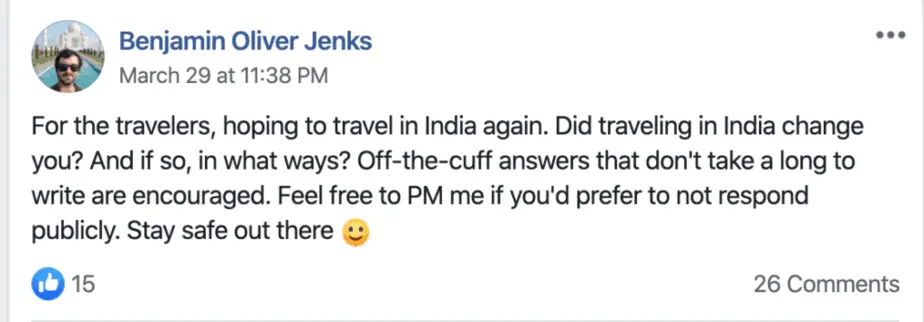
The Traffic

Jumping in an Uber at 4 AM at the Chennai airport was a transformative experience. No seat belts. Heading the wrong way on one-way streets. My driver was asking me about Trump as a president. He liked Obama though, especially his daughters… “very pretty.”
I showed him where my hotel was on Google Maps, yet it still took us 45 minutes to get there once we were within a few miles. He was waking up rickshaw drivers sleeping on their carts and asking them for directions. He got me where I needed to go though and had a super chill fun attitude about it.
Driving through Chennai’s traffic the next day with scooters inches from my taxi I thought two things:
- I’m NEVER driving in these streets.
- I’d bet I’ll see an accident in the three weeks I’m on this trip.
However, in a week I rented my own scooter and was driving through the streets. AND I never saw an accident on that trip.
Now after living and traveling here since 2018, I still haven’t witnessed a traffic accident. I did see the scene of one AFTER the fact, and I’ve bumped a few scooters and pedestrians with my mirror as I’ve driven about.
While it’s cool that everyone goes with the flow and there are fewer rules, road safety is a big problem in India.
The National Crime Records Bureau (NCRB) found that were 464,674 road traffic accidents in India in 2015 which lead to 148,707 deaths. With 182.45 million vehicles and a population of 1.31 billion people, the traffic collision rate is about 0.8 per 1000 vehicles, and a fatality rate of 11.35 for 100,000 people.
For comparison in the USA, the National Highway Traffic Safety Administration reported 37,461 fatalities (over 100,000 less than India) with a fatality rate of 1.18 deaths per 100 million vehicles with a total population of 323,400,000.
But the population of India is just over 4 times as large as the USA’s.
If we multiply the number of fatalities in the USA by 4, then it is more than what India has. It would be 151,717 fatalities!
Of course, this issue is more complex than a simple calculation, but my point is simply… the traffic in India is insane but for the most part everything runs pretty smooth and everything works out.
The Food
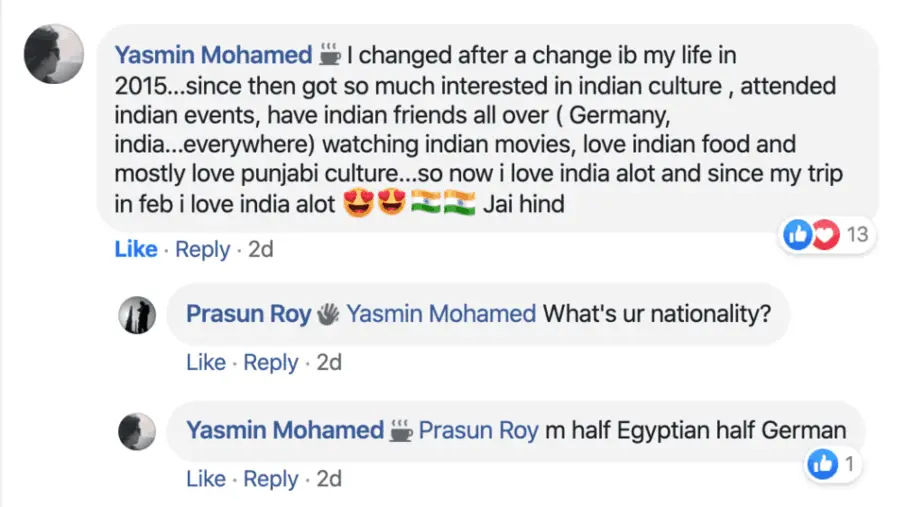
Indians take great pride in their cooking and it shows. If I was making Indian food in the USA, I would probably buy a pre-made packet of masala curry, then heat it up and squirt it on some rice. If someone tried this in India, you’d be whacked with a large stick.
Recipes are handed down from generation to generation. Meals are prepared spice by spice and ingredient by ingredient. There is NO Wal-mart and you probably buy your ingredients from a local market.
In South India, turmeric, coriander, cumin, mustard seeds, black pepper, chili powder, curry leaves, cardamom, and cinnamon are commonly used.
A thali is a typical lunch here and it varies from restaurant to restaurant. There might be beetroot salad at one restaurant with chickpeas and at the next, you could have paneer butter masala.
The food varies by region from South India’s spicy simple foods to Northern India’s nutty creamy gravies and Kerala’s fresh seafood and traditional beef dishes.
The Cost of Living

- The average cost of rent in Manhattan for a one-bedroom apartment in New York City is $2,098 a month.
- The average cost of rent in San Francisco for a one-bedroom apartment in California is $3,500 a month.
- The average cost of rent in a smaller city like Austin for a one-bedroom apartment in Texas is $1,186 a month.
- Even in a small city like Des Moines, Iowa the average cost for a one-bedroom apartment is $703 a month.
- I pay $167 a month for a two-bedroom apartment in a small city in India.
My flat is quiet, spacious with big windows and surrounded by nature and a small temple. I have everything I need for less than what I paid to live in a friend’s garden shed in Austin.
For comparison:
- The average cost of a one-bedroom apartment in the city center of Goa is $166 USD a month.
- The average cost of a one-bedroom apartment in the city center of Mumbai is $589 USD a month.
- The average cost of a one-bedroom apartment in the city center of New Delhi is $225 USD a month.
This data from users at Numbeo who live in these destinations.
It is refreshing to see families living in a one-room cement building, and they seem pretty happy. I watch them sitting outside their home talking to their neighbors, the kids playing together and everyone knows each other.
The Architecture
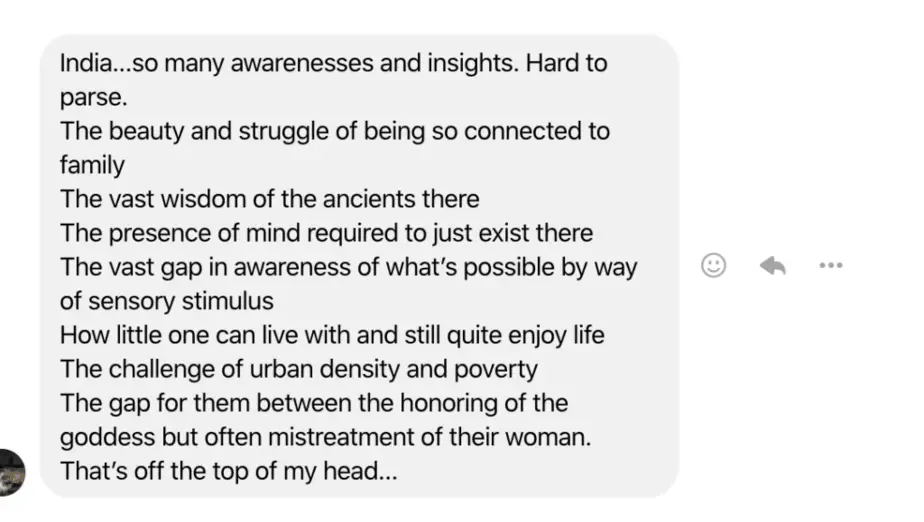
The Taj Mahal was built between 1632-1648. Agra Fort was build between 1565-1573. The temple in my town was built in the 9th century. The erotic temples in Khajuraho were built between 950 and 1050 AD.
The Empire State Building was built in 1930. The Golden Gate Bridge was built in 1933.
Scholars believe the city of Varanasi to be around 3,000 years old. Whereas, New York City is 400 years old.
Walking around the temples in Khajuraho, our tour guide describes the temples that were carved +1,000 years ago, as the “movies of that day.” Looking at the carvings of spiritual teachers, students, war elephants, and erotic activities takes you way back to a different way of living that’s hard to imagine.
The Hospitality
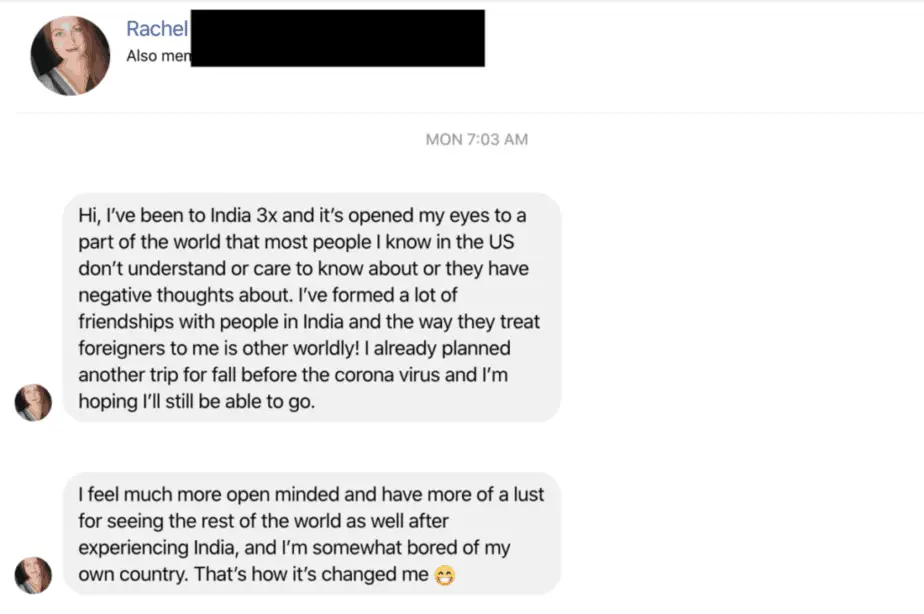
“Atithi devo bhava” or translated into English means, The guest is god.
This phrase comes from the Taittiriya Upanishad, Shikshavalli I.11.2 matrudevo bhava, pitrudevo bhava, acharyadevo bhava, atithidevo bhava. It literally means: “be one for whom the Mother is God, be one for whom the Father is God, be one for whom the Teacher is God, be one for whom the guest is God.”
Namaste means I bow to the divinity in you 🙏
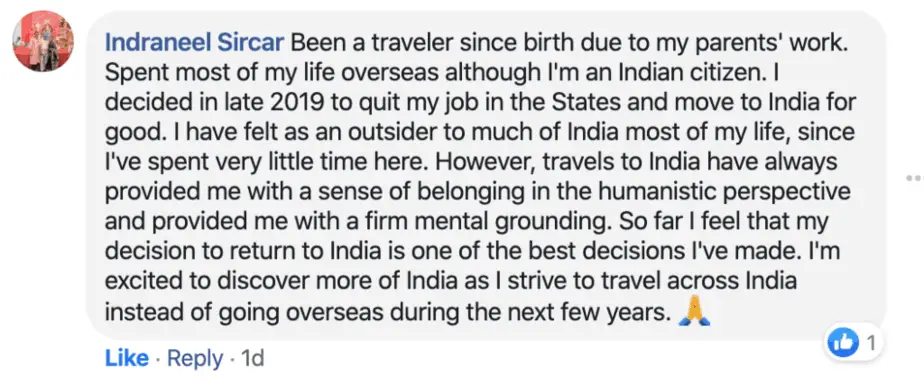
There are five things to do if you are welcoming guests into your home:
- Smell (Dhupa) – Light incense or provide a sweet-smelling fragrance.
- Light (Dipa) – Use lights or lamps to light your space in a beautiful way so that everything can be seen to relax your guest.
- Food (Naivedya) – Fruits, juices and sweets are usually offered.
- Rice (Akshata) – It is a symbol of being connected and put on the forehead.
- Flowers (Pushpa) – You might see hotels putting garlands over a guests head as they arrive and that comes from this tradition. Flowers are a gesture of good will.
The tourism industry uses this sacred practice to attract more tourists to India as well. Incredible India was a marketing campaign that started in 2002. It’s working too, if you check the stats from the Ministry of Tourism about how many foreign tourists visit India…
| Year | Foreign Tourists in India (Millions) |
| 2002 | 2.38 |
| 2003 | 2.73 |
| 2004 | 3.46 |
| 2005 | 3.92 |
| 2006 | 4.45 |
| 2007 | 5.08 |
| 2008 | 5.28 |
| 2009 | 5.17 |
| 2010 | 5.78 |
| 2011 | 6.31 |
| 2012 | 6.58 |
| 2013 | 6.97 |
| 2014 | 7.68 |
| 2015 | 8.03 |
| 2016 | 8.80 |
| 2017 | 10.04 |
The Negotiating

When I rented my apartment, I negotiated to save 3,000 INR a month ($40 USD). When I went on a tour in North India, I negotiated to not pay for the credit card/bank transfer fee and saved $20 USD. When I was buying furniture and a mattress, I negotiated $10 off the $100 price.
Every price in India is negotiable. From the hotel prices to the vegetables you buy in the market. It’s just how things are done, and frankly, Indian merchants are very good at it.
As I get more practice, the way I view prices has changed. It’s not what the price is stated but what the merchant will accept or the customer will pay. Or what I will pay.
The Vast Population of People

India has a population that is projected at 1.38 billion in 2020. It is the second most populated country in the world.
- India has 411 people per square kilometer
- USA has 33 people per square kilometer
People are everywhere. The concept of “personal space” that is so prevalent in Western society is a luxury that most people in India don’t have. Extended families live together in one house. And while being so close to people makes me sort of miserable, it’s fascinating to watch how the Indian people don’t seem to be bothered by it and how thick their skin is.
The Spirituality

Temples are as prevalent as McDonald’s in the USA. Hindu has 33 million gods. Religion and god comes first in India. There are spiritual holidays and celebrations happening in what seems like every weekend.
Everything relates back to their spirituality from the holidays to the rituals to the food.
It’s cool that it’s socially acceptable to devote your life to spirituality like the sadhus and holy men do.
Family
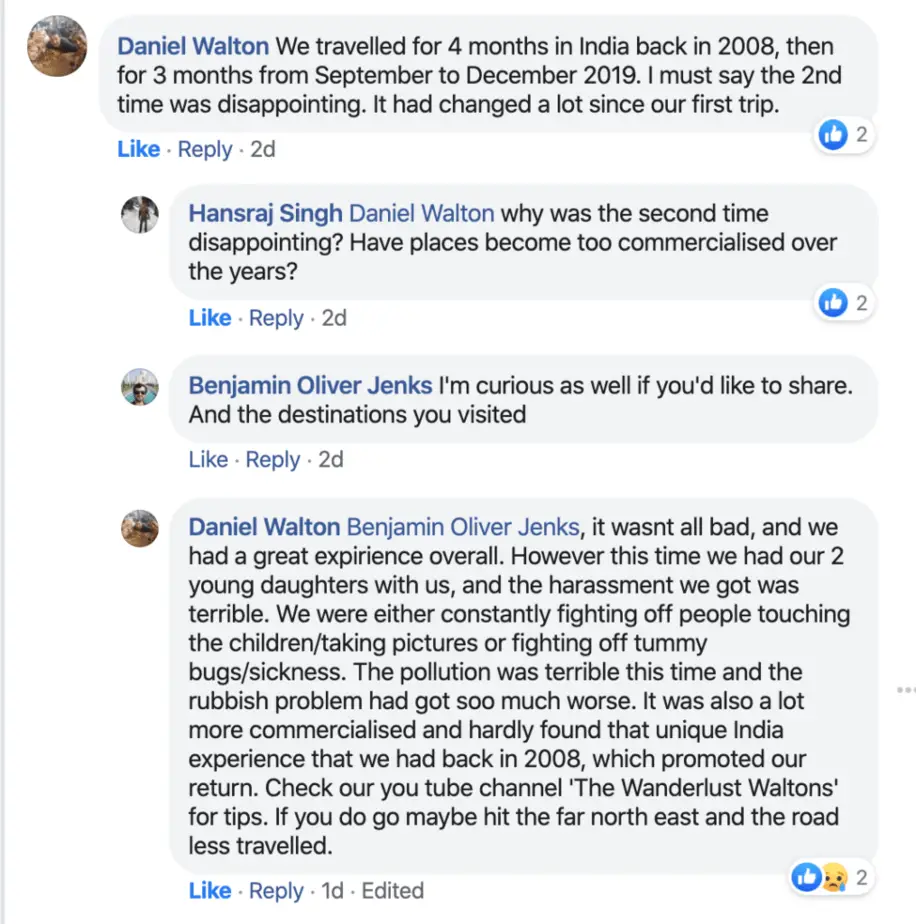
I’m a bit jealous of how close the people are here with their family. I value my independence and love to live alone but when I see families laughing or even fighting, you can just tell how close they are.
People here don’t understand how someone can not be married at my age or why they would leave their family. It makes me appreciate my family and want to call them and hear from them. Then one day it’d be nice to settle down and live closer to them.
The Poor

Walking the streets in India can be heartbreaking. Women hold babies awkwardly and hold out their hands for money for “milk.” Kids chase you and look super cute and ask for money “sir.” A man without any legs pushes himself along the street on a wooden crate asking for money every day when I pass on my scooter. Another man without an eye asks me for money and hits me on the shoulder when I say no.
India can break your heart. I picture how many people have never had nor will have the opportunity to go to school until they were 18. Or get an education. Or get a job where they made more than they were able to spend. I’m so lucky. And there’s nothing I can for most of these people. 🙁
Appreciation of Home
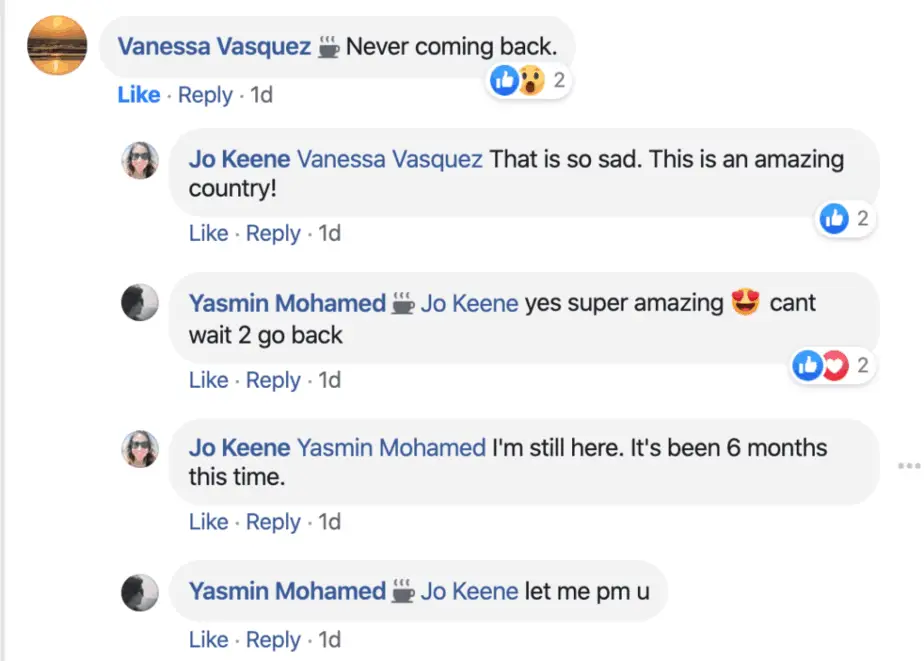
My mom came to visit and when we’ve spoken after her trip, it’s clear how much she appreciates her home now. She lives on a quiet lake in northern Michigan. She has a loving husband, a small community of friends and goes to church every Sunday.
Her trip to India opened her eyes in many ways and made her appreciate where she lives more.
I’m still here in India living and traveling, and I’ll be here much longer if things go as planned. But I hope when I eventually move back to the USA that I’ll remember these experiences and that India will have changed my life as well.

Related Questions:
What Should You Know Before Going To India?
- India has everything you need, so you don’t need to buy everything before your trip.
- Don’t exchange money at the airport.
- Get an atm card without ATM fees. ATMs get the best exchange rate.
- Print paper copies of all important documents: your visa, passport, driver’s license, hotel reservations, and plane tickets.
- Credit cards are accepted in more places than you’d think. Bring some with zero international transaction fees.
- Local sim cards for your phone can cost ~$3-$7 a month.
- Uber and other taxi apps are available in most major cities and offer better prices than local taxis (without having to negotiate prices).
- Always try to break your big bills like 500 and 2000 rupees. Small shops won’t have change.
- Don’t drink the water.
- It only takes a day or so to get approved for an e-visa before your trip. Get it about 3 weeks before your trip.
Is India Good To Visit?
You can see historic architecture like the Taj Mahal, Red Fort, Jaipur’s Pink City, and the oldest city in the world, Varanasi. You will see things you never see in Western cities because the population density means people are everywhere and are used to people being everywhere. The people are so friendly about taking photos usually. India is safer than it looks at first but check the travel advisories before you go and be street smart.
Planning A Trip To India?
Use hotel booking sites like Booking.com. Buy your flight 6-to-7 weeks before you go for the best prices. Get your visa 3 weeks before you go if your trip is less than one month. Get in shape and have walking shoes that you love.

